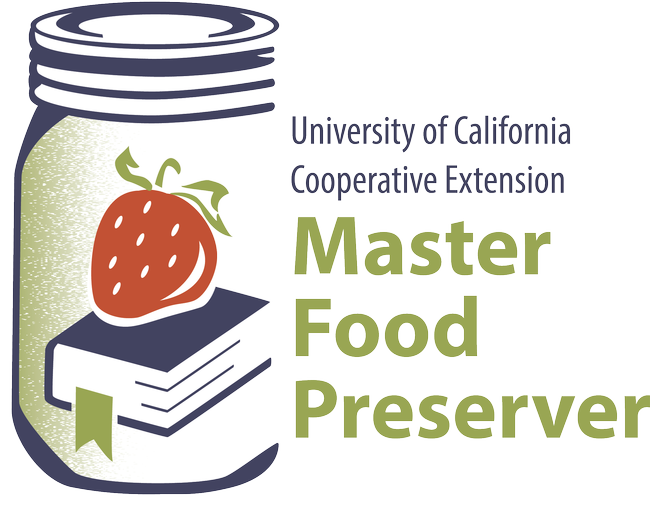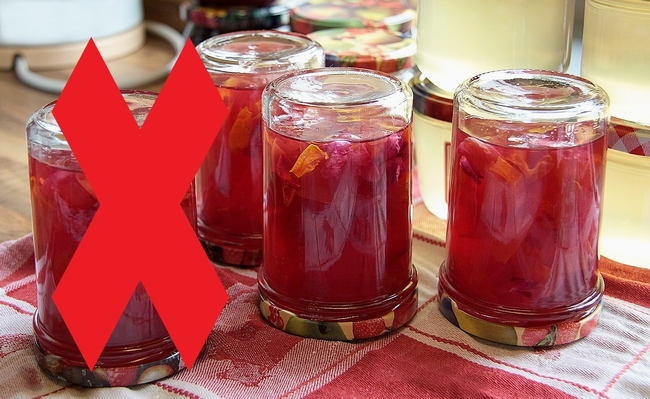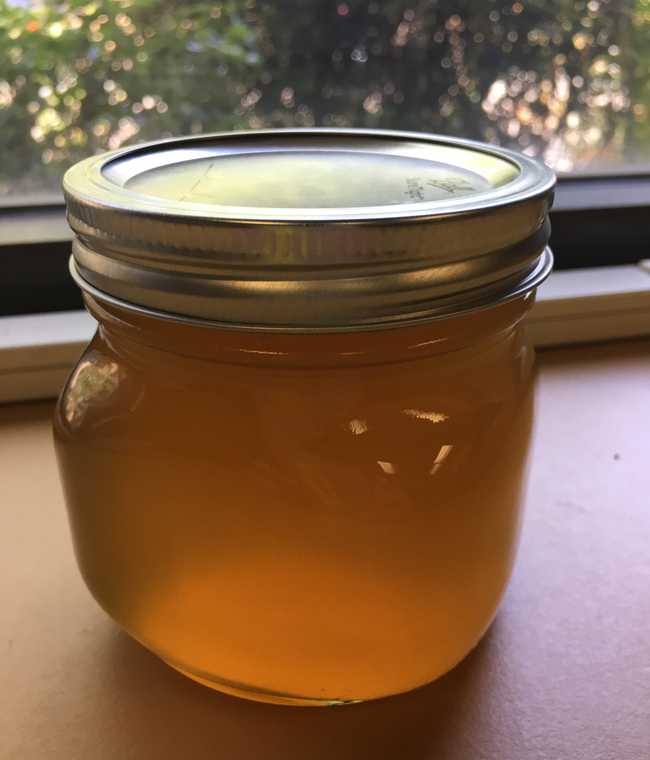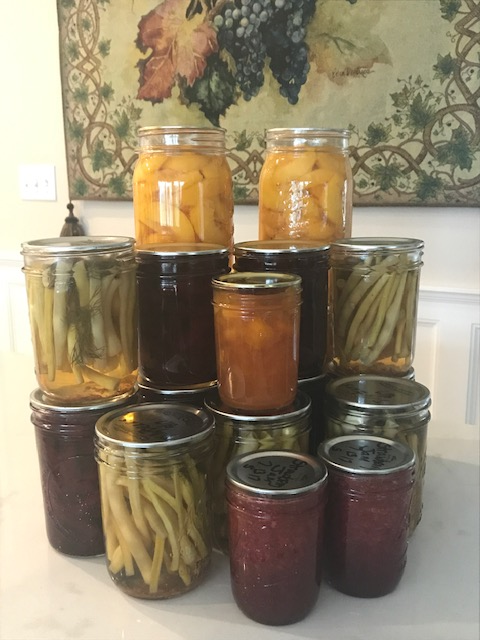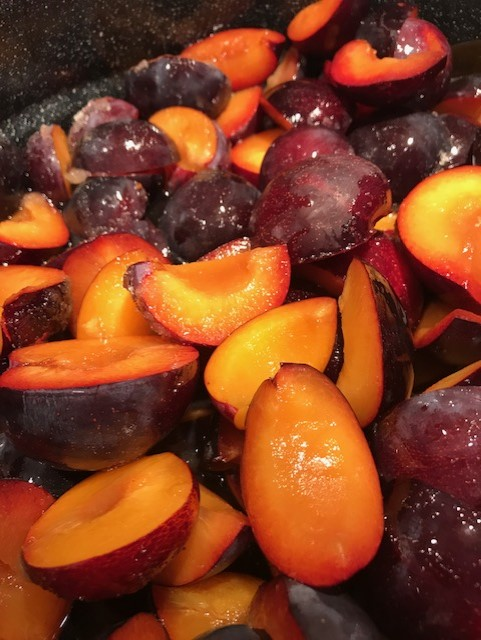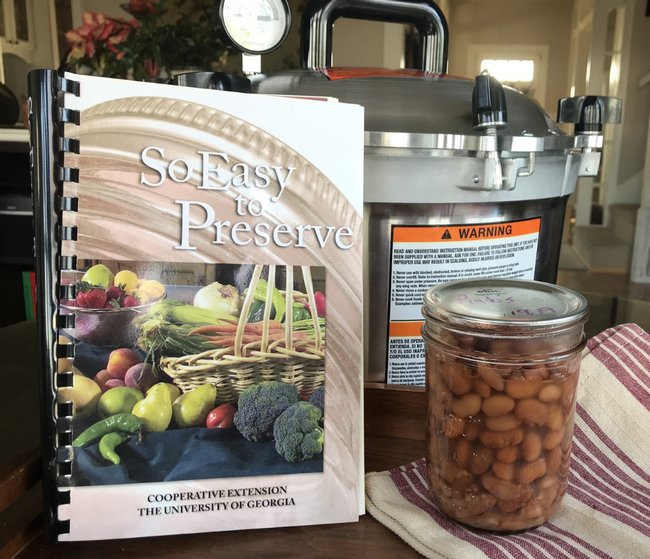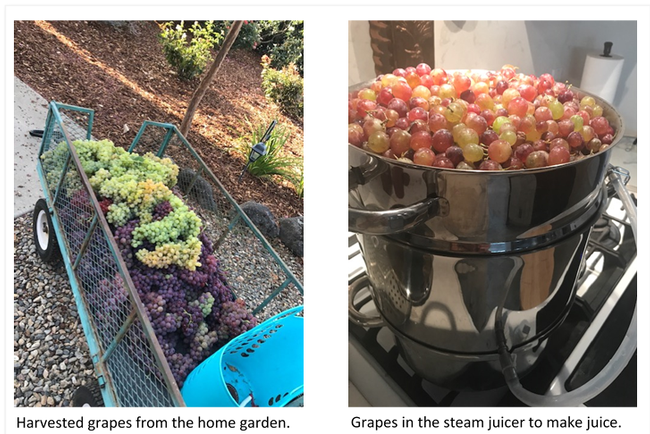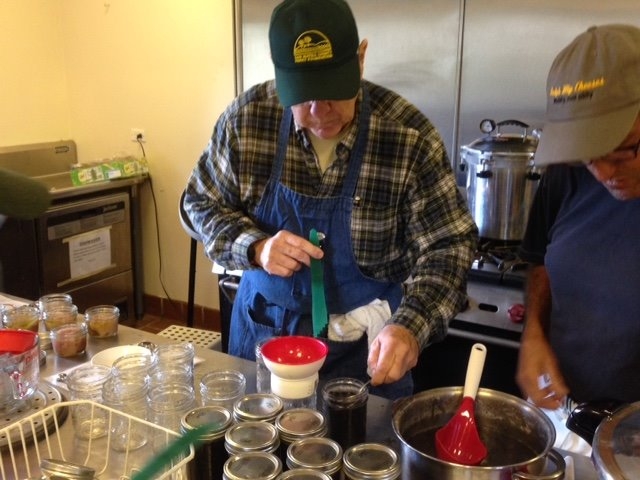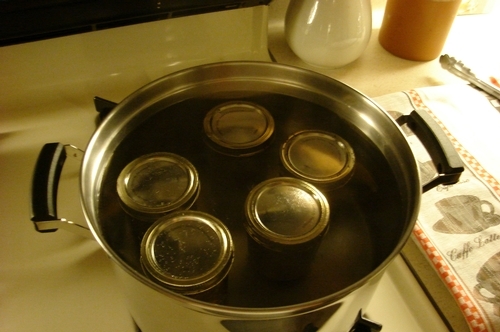Posts Tagged: Canning
Not your grandma’s jam
As a UC Master Food Preserver Program Coordinator, I've had the privilege of teaching new volunteers eager to learn more about food preservation, who then teach in their local communities.
Many students are experienced food preservers, creating delicious jams and jellies for their family and friends. It's exciting to see the ah-ha moments when I explain and discuss the reasons behind the research-based preservation techniques UC Master Food Preservers teach. Just because grandma or mom did something and no one got sick, does not mean that the process is safe by today's standards.
The traditional methods of preserving jams and jellies was to cook the product, put it in a sterile jar, and either pour melted paraffin wax on top or put a lid on then turn the jar upside down to force a seal. Each method has its own set of food safety concerns.
Using paraffin wax to create a barrier between the jam or jelly and the surrounding environment was fairly effective as long as the product was stored in a consistently cool place, such as a root cellar. Not many of us have the luxury of a root cellar. Unfortunately, if the storage temperature of the jar fluctuates, the wax contracts with cold temperature (letting in pathogens and – in my country house – ants) and then expands with warm temperatures to trap the undesirables in the product beneath the wax.
If there was mold under the wax, it was a common practice to scrape it off since it only appeared to be on the surface. We know better now. Molds don't just grow on the surface, they can create carcinogenic toxins (mycotoxins) that remain in the food, invisible to the human eye.
Another common canning practice was to sterilize the jars, fill almost to the top with hot jam or jelly, put the lids on, and turn the jars upside down to force out the air and create a vacuum seal. This is open kettle canning. This method made a more consistent barrier than wax, but there is still a common potential problem with the food inside the jar: there is no guarantee you destroyed all food borne pathogens and spoilage organisms.
When we boil jam and jelly in a cooking pot, we still don't reach a high enough temperature to destroy all spoilage and food poisoning organisms. Plus, the air is filled with floating microorganisms trapped in the jar when we add a lid. When we process a jar of jam or jelly in a boiling water or atmospheric steam canner, there's enough of an increase in the temperature within the jar to destroy the pathogens and enough of a pressure increase to force air out of the jar. When we remove the jars from the canner, the pressure equalizes and the vacuum seal forms over pathogen-free food.
Often people don't realize the purpose of adding (so much!) sugar to a jam and jelly isn't just to add sweetness. Sugar preserves the food and partners with the pectin to form the gel.
When I teach about the purpose of sugar in a jam or jelly, I have students (youth and adult) act out what happens in a jar of jam. Three volunteers at the front of the room represent water, sugar, and pathogens (the bad guy). Foodborne pathogens need water to grow, so if the pathogens have access to the food's water (the water and pathogen volunteers link arms), the pathogens do what they're supposed to do: grow mold, slime, fuzz – all that disgusting stuff you find growing in the containers shoved at the back of your fridge. We need to separate the water in food from the pathogens, so we bring in sugar. At a molecular level, the sugar molecules bind with the water molecules (the water volunteer now links arms with the sugar volunteer, leaving the pathogen volunteer off to the side). This bonding lowers the water activity of the food, making the water unavailable to the pathogen (private party by invitation only). The pathogen wants to join the food party but the sugar acts as a bodyguard, keeping the pathogen away from the food's water and preventing the pathogen from growing (the sugar volunteer blocks the pathogen volunteer from getting near the water volunteer). That's how sugar preserves the jam and jelly.
But what if you want to have a low sugar jam or jelly (aka fruit spread)? First, use a pectin and recipe designed for low-sugar to get a good gel. (Low-sugar pectin uses calcium instead of sugar to make the gel. Regular pectin uses sugar to make the gel, so if you just cut the amount of sugar, you'll make a delicious runny syrup.) Second, process the fruit spread in a boiling water or atmospheric steam canner to destroy the microorganisms. While the jar is sealed, nothing will grow. Unfortunately, once you open the jar, there isn't enough sugar to prevent microorganisms from growing (you have a tiny sugar bodyguard). Even stored in the refrigerator, mold forms within a couple of weeks and you need to toss the fruit spread. I always recommend canning low-sugar fruit spread in small 4-ounce jars to make it easy to finish using the product before it molds.
Knowing why current canning recommendations work is key to ensuring the jams and jellies we serve to our friends and family are safe to consume. UC Master Food Preservers rely on the National Center for Home Food Preservation for their information; you can, too!
For more information about the UC Master Food Preserver Program, including the Food Preservation Video Library, visit mfp.ucanr.edu.
Home preservation for whole foods, plant-based lifestyles
Recently there has been increasing interest and desire to grow and preserve our own produce. In addition, there has been an increase of health-conscious families turning to WFPB lifestyles. This UC Davis article explains the differences between vegan and WFPB diets.
Home food preservation is a natural accompaniment to this lifestyle, however, misconceptions about the benefits of home canning are often overlooked for the WFBP lifestyle and therefore not utilized. There is a misconception that preserved canned fruits are loaded with sugar. Unlike vegan diets, WFPB diets do not include sugar, however, WFPB diets do include raw honey if sweeteners are desired. The UC Davis Integrative Medicine article, The real truth about sugar, supports the choice to preserve fruits without the addition of sugar. And, although unprocessed foods are encouraged, minimally processed foods like home preserving, is acceptable. Here is a great article from UC Davis Integrative Medicine - What about processed foods?
Having a small orchard with cherries, peaches, plums and apricots, as well as grapes and blueberries, I spend my summers preserving fruits with no sugar. I would freeze, can or dehydrate the fruit to enjoy during the off seasons as well as making jams and jellies using Pomona's Universal Pectin without sugar, and instead using honey to add sweetness. Preserving with Pomona's Pectin preserving cookbook is an excellent resource for canning without sugar.
Beans are a protein staple for the WFPB lifestyle. A UC Davis Integrative Medicine article explains Why beans are best and are a healthful choice for a meal or a snack. Home canning beans saves time and money. This UCCE video by Dustin Blakey is an excellent demonstration for pressure canning beans. By following the recipe in the book So Easy to Preserve, for pressure canning beans, my beans always come out safe and perfect. Before serving, I bring the beans to a boil for 10 minutes and season for my desired taste.
Being a certified UC Master Gardener provided me the skills and knowledge to successfully grow my own produce. I often referr to my garden as “My Victory Garden for Health.” All the produce that is not eaten fresh is either canned, dehydrated or frozen using skills I learned as a UC Master Food Preserver.
We grew a large 4' x 16' bed of onions. Some onions were dehydrated, which was a great advantage. Snap peas, bush beans, asparagus, beets for pickling, carrots, tomatoes, and sweet corn were either pressure canned, blanched or frozen. Vegetable soup was made and canned using the So Easy to Preserve instructions.
I am not advocating that this lifestyle is for everyone since after almost one year I found my way to a hybrid form of WFPB. However, I will continue to use my UC Master Food Preserver skills to home preserve produce that is sugar free and healthy, knowing that my home preserved food is safe since I have followed recipes and procedures tested for home food preservation.
For more information about the UC Master Food Preserver Program, including the Food Preservation Video Library, visit mfp.ucanr.edu.
Demand grows for UC Master Food Preserver classes
Californians' growing interest in where their food comes from has revived the art of putting up food – canning, drying, freezing and pickling – for later. People who didn't learn food preservation from their parents or grandparents are flocking to UC Cooperative Extension Master Food Preserver classes.
Although UC Cooperative Extension started offering the program in a few counties in the 1980s, its parent organization UC Agriculture and Natural Resources recently designated it as a statewide Master Food Preserver Program.
UC Master Food Preservers are volunteers who teach people in their communities about food safety and how to preserve food. Certification entails about 50 hours of instruction and a commitment to volunteer service to the program.
In the fall, UC Cooperative Extension held a course to train and certify UC Master Food Preservers in Los Angeles.
“I had 86 applicants for 18 spots,” said Drusilla Rosales, a UC Cooperative Extension advisor who oversees the program in Los Angeles County. “It's very much in demand. I get requests almost daily from people who are either looking for a class or wanting to become certified as a UC Master Food Preserver.”
“People are chomping at the bit for this course,” said Virginia Bolshakova, UC Cooperative Extension director for San Mateo and San Francisco counties, who is trying to build the local Master Food Preserver Program slowly. “I have a feeling we're going to have to turn away 75 percent of the people that apply this time around! Our phones are ringing off the hook about this program.”
The program is currently located in 16 counties and expanding.
“We are hiring a staff person to move things forward and expect to have more resources for existing UC Master Food Preserver programs in the near future,” said Missy Gable, UC Cooperative Extension statewide Master Food Preserver Program co-director and UC Master Gardener Program director.
“One of our priorities is to increase diversity among volunteers in terms of ethnicity, language and the areas of Los Angeles they're from, this way we'll be better suited to reach a broader audience and serve the needs of our community” said Rosales, a UC Cooperative Extension nutrition family and consumer sciences advisor in Los Angeles County.
Most of the 46 MFP volunteers are in west Los Angeles and hold workshops at farmer markets, do demonstrations at community gardens and staff booths at the Los Angeles County Fair. They have begun reaching out to low-income residents and high school students.
“Some of our UC Master Food Preserver volunteers are working with high school students,” said Rosales. “A lot of schools now have gardens and one of the high schools has a culinary arts program and a beautiful new kitchen to prepare students for careers in the food industry. MFP volunteers have been teaching students how to dehydrate herbs and cook with herbs and dehydrate kale to make kale chips. They are also teaching jams and jellies classes.”
In Orange County, UC Master Food Preserver volunteers are working with UC Cooperative Extension's 4-H Youth Development Program to create a Junior Master Food Preserver Program for youth. One goal of the program would be to give students an opportunity to earn a certificate in food preservation that they can put on college or job applications.
For more information about the UC Cooperative Extension Master Food Preserver Program, visit http://mfp.ucanr.edu. To find an MFP program near you, visit http://mfp.ucanr.edu/Contact/Find_a_Program.
In the video below, Missy Gable, talks about plans for UC Cooperative Extension's statewide Master Food Preserver Program.
.
To watch Susan Algert, UC Cooperative Extension advisor, demonstrate safe canning practices in a video, visit https://www.youtube.com/watch?v=SeoymcsLWlg.
Master Food Preserver program in California is on the upswing
Home food preservation had been simmering on the back burner for years, but growing interest in eating healthy, local food and a revival of America's can-do spirit has it jamming once again.
The UC Cooperative Extension Master Food Preserver (MFP) program is following the same trend. Established in the 1980s, a small contingent of volunteers offered occasional classes through the years. But a reawakening that spurred rapid program growth was enough to prompt UC Cooperative Extension to hold the first-ever statewide Master Food Preserver conference this month in Stockton.
Master Food Preservers are volunteers who teach people in their communities how to preserve food safely and nutritiously. Nine California counties now have MFP programs and more are planned. Last year, MFP volunteers clocked 15,000 hours teaching courses on safe food preservation. The statewide conference was designed to give the volunteers a networking opportunity, updates on the latest food preservation techniques and tools, and energy to return home and meet the increasing public demand.
“There is a huge resurgence of interest in food preservation among young people,” said Missy Gable, the co-director of the UCCE statewide Master Food Preserver program and director of its Master Gardener program. “People whose parents and grandparents didn't preserve food now want to learn how.”
At the conference, chef Ernest Miller, a certified Master Food Preserver in Los Angeles County, outlined the storied history of food preservation, which he says predates agriculture.
“You decide to grow food. You're successful. You have a big harvest and throw the first harvest party,” Miller said. “One week, two weeks later, all the food goes bad. You starve to death and the experiment is over. You need to know how to preserve food before you can switch from hunting and gathering to agriculture.”
Miller believes food preservation is the foundation of civilization and the key to the world's cultures.
“Where would the French be without cheese? What would the Japanese be without sunomono, the Koreans without kimchee, the Germans without sauerkraut and beer?” he asked.
A proponent of all types of food preservation, Miller can rattle off a litany of processes in a few seconds.
“We teach canning, pressure canning, freezing, drying, pickling, fermenting, curing, brewing, smoking, charcuterie, cheese making and emergency food storage,” he said to cheers from the audience.
Three Master Food Preservers shared proven teaching techniques with their colleagues at the conference.
Sue Mosbacher, UCCE program representative for the MFP program in Amador and Calaveras counties, said she always begins a class on pressure canning by asking who's afraid of the process. Many hands go up and members of the audience tell of times their grandmothers' pressure cookers exploded.
“What were they cooking? Split pea soup and the peas clogged the vent. With pressure canning, we're just using water,” Mosbacher said. “The first thing I do is reassure them that a pressure canner is a very safe tool to use.”
Mosbacher gets her students excited about canning their own beef stew by trying to read the ingredients on a store-bought stew can, and then the ingredients in her home-preserved stew.
“Potatoes, carrots, onions, beef and a little broth, that's it. And it's delicious,” she said.
MFP Cheryl Knapp of El Dorado County showed that food preservation isn't limited putting up plain fruit and vegetables for future consumption. In her classes, she teaches how to make homemade spice blends using dried peppers and other vegetables from the garden.
MFP Linda Bjorkland of Sacramento County demonstrated an automatic jam and jelly maker she received as a gift. At first she was skeptical, but tried it.
“You just sprinkle the pectin, add a half teaspoon of butter, and the strawberries,” Bjorkland said. “What's the next step? Turn it on. Can you believe that?”
A hot plate heats the mixture evenly and a blade inside the pan stirs continuously. When the maker beeps, add sugar.
“It continues for 17 minutes, and your jam is done,” Bjorkland said. “It's quick and easy. That's the kind of thing your public will want to know about.”
The UCCE Master Food Preserver program is setting up a statewide steering committee, will soon launch a new, completely updated website, and a team of MFP volunteers and UC nutrition specialists are writing a comprehensive MFP handbook.
“This is a labor of love,” Gable said. “I'm thrilled about the developments in our program.”
Making a comeback
One of the great "lost" arts making a comeback is home food preservation. Call it a return to basics, the influence of the slow food movement, or an offshoot of a renewed interest in home gardening - canning is back!
Making jam, preserves, or jelly using the waterbath method is one of the easiest ways to make an entry into canning. Several years ago I started a jam contest in my office as a covert way to get rid of my proliferation of Elephant Heart plums. At first, my co-workers were reluctant to join in the fray, until I told them, "You know that saying 'Easy as pie'? That's a lie. Pie is hard. Jam is easy." And easy it is.
If you're ready to try your hand at preserving, the University of California and UC Cooperative Extension offer a wealth of information for home preservers.
First up, are UC ANR's free downloadable publications on home preservation and storage. Included in this list is the series Safe Methods to Store, Preserve, and Enjoy. From apples to tomatoes, these handy publications include tips on food safety as well as recipes. I made a very tasty jam from the publication Peppers: Safe Methods to Store Preserve, and Enjoy and wrote about it in an earlier blog post.
Also making a big comeback are the UC Master Food Preservers (MFP). Akin to the UC Master Gardeners, these UC-trained volunteers have completed a 12-week session led by UC-certified Master Food Preservers. Once trained, MFP's pass on their knowledge to the public and commit to completing 30 volunteer hours and 15 continuing education hours each year.
At present, a limited number of UC Cooperative Extension offices offer the program, but it is growing strong. The web sites of these UC MFP programs also contain a wealth of information for home preservers.
If you can't get into a UC MFP class, the Ball website has an extensive list of classes.
The UC Center for Food Safety's website contains an exhaustive list of resources from universities, the USDA, as well as links to manufacturers of canning supplies. My favorite is the encyclopedic Judging Home-Preserved Foods from the University of Georgia. This would have come in handy for the plum jam contest!
By the way - if you have a favorite canning jar, I recommend buying early in the season to make sure you get your favorite while it is still in stock. My favorite, the half-pint wide mouth jar, is impossible to find after the end of June.

